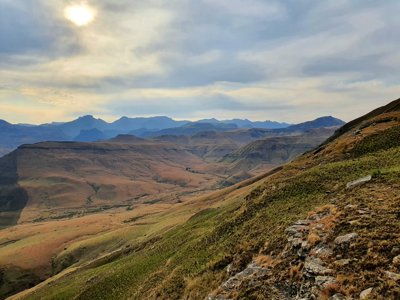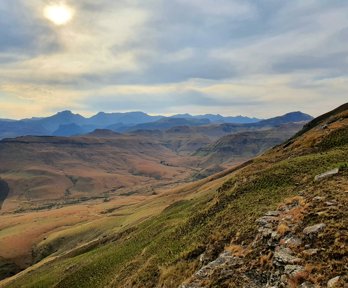Key words
-
Glaciers
-
Periglacial
-
Last Glacial Maximum
-
Africa
-
Geomorphology
-
Past climate reconstruction
Summary
Location
Fieldwork for this project took place in September 2011 and the research is ongoing. Landform mapping and sampling was undertaken in the Drakensberg Mountains in South Africa.
Overview
This research project looks at evidence for the presence of glaciers in the Drakensberg Mountains in the past; both to better understand the glacial history of the area and to infer the past climate conditions that must have existed to allow glaciers to form here. The research also compares the evidence from the Drakensberg Mountains with evidence for past changes in ocean currents and sea surface temperatures off the coast of South Africa to help better understand the links between changes in ocean circulation and the climate of southern Africa.
Research techniques
Prior to fieldwork, satellite images and aerial photos were examined to identify glacial and periglacial landforms. Landforms were then mapped in the field using a Global Positioning System (GPS) to ‘ground truth’ the inferences made from studying the ‘remotely sensed’ images. Sections through the landforms were logged and the sedimentary properties recorded (for example, clast size and orientation). Landforms were also sampled for surface exposure dating (to determine the age of certain glacial and periglacial landforms). Once glacial landforms have been identified and dated, another step involves inputting field mapping data into a Geographical Information System (GIS) in order to estimate the dimensions of a former glacier.
Aims
-
To improve knowledge of where glaciers formed in the Drakensberg, and when they existed; and to determine whether certain landforms are glacial or periglacial in origin
-
To use this knowledge to infer what the climate was like in the High Drakensberg in the past, and to investigate how past climate changes in this region related to past changes in the strength of the Agulhas Current off the coast of southern Africa
Key topics and themes
This resource will be of particular value to A-level students studying glaciation and cold environments. It provides:
-
A case study of a formerly glaciated area and the evidence used to both reconstruct the location and size of past glaciers and to determine when they existed
-
An overview of what the Drakensberg Mountains were like during the same time frame when the British Isles were covered by a great ice cap (the Last Glacial Maximum)
It is also relevant for A-level studies of climate - specifically the nature and causes of climatic variation over long timescales, as well as the methods by which past climates are reconstructed.
-
The presence of glaciers in places where they no longer exist today indicates that climate has changed - as such places must have been colder and/or have received more precipitation in the past to have had glaciers
-
Understanding of longer-term changes in climate is essential for putting human-caused climate change into perspective and for predicting how the climate is likely to change in the future
Documents to download
-
Teacher guidance notes
-
Links to exam specifications
-
References
Video clips
-
Lesson one – Introducing the High Drakensberg
-
Lesson three – Sampling for surface exposure dating
Additional links
For additional teaching resources on researching long term climate change:
For additional teaching resources on research in geomorphology:
About the author
Dr David Anderson is Head of Geography at Eton College. His doctoral research at the University of Oxford involved reconstructing past environmental and climatic changes from stratigraphic evidence. He is the author of the A-level text Glacial and Periglacial Environments (Hodder) and a co-author of Global Environments through the Quaternary: Exploring Environmental Change (OUP). He also co-authored the A-level section of the Discovering Antarctica website for the RGS-IBG.
The researchers
Stephanie Mills and Tim Barrows
Dr Stephanie Mills is a lecturer in Physical Geography at Kingston University London. Dr Timothy Barrows is a Senior lecturer in Physical Geography at the University of Exeter. They received the Peter Fleming Award in 2011 to support their work on the ice age climate of the Drakensberg Mountains, southern Africa.


